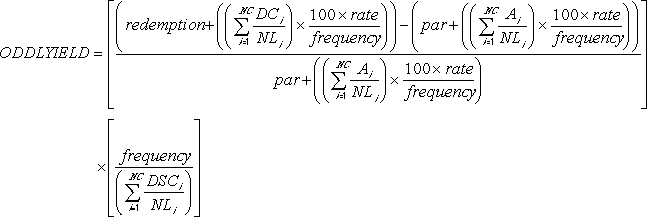ODDLYIELD
Syntax:
ODDLYIELD ( settlement , maturity , last-interest , rate , pr , redemption ,frequency [ , [ basis ] ] )
Description: Computes the yield of a security that has an odd (short or long) last period.
Mathematical Formula:

where:
Ai = number of accrued days for the ith, or last, quasi-coupon period within odd period counting forward from last interest date before redemption.DCi = number of days counted in the ith, or last, quasi-coupon period as delimited by the length of the actual coupon period.NC = number of quasi-coupon periods that fit in odd period; if this number contains a fraction it will be raised to the next whole number.NLi = normal length in days of the ith, or last, quasi-coupon period within odd coupon period.
Arguments:
Name |
Type |
Description |
||||||||||||
|---|---|---|---|---|---|---|---|---|---|---|---|---|---|---|
settlement |
number |
The security's settlement date. |
||||||||||||
maturity |
number |
The security's maturity date. |
||||||||||||
last-interest |
number |
The security's last coupon date. |
||||||||||||
rate |
number |
The security's interest rate. |
||||||||||||
pr |
number |
The security's price. |
||||||||||||
redemption |
number |
The security's redemption value per $100 face value. |
||||||||||||
frequency |
number |
the number of coupon payments per year. (For annual payments, frequency is 1; for semiannual payments, frequency is 2; for quarterly payments, frequency is 4.) |
||||||||||||
basis |
number |
The truncated integer type of day count basis to use, as follows:
|
Time information in the date arguments is ignored.
Return Type and Value: number – The yield of a security that has an odd (short or long) last period.
However, if
settlement, maturity, or last-interest is out of range for the current date base value,
#NUM!is returned.The following is not true: maturity is later than settlement, which is later than last-interest, so
#NUM!is returned.rate or pr < 0,
#NUM!is returned.frequency is any number other than 1, 2, or 4,
#NUM!is returned.basis < 0 or basis > 4,
#NUM!is returned.